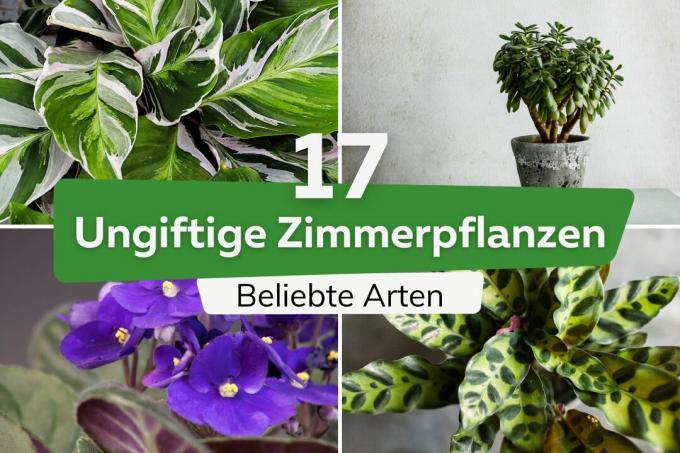
Plants not only beautify your home, they also contribute to the well-being of the residents. If you include children and pets, however, you should use non-toxic houseplants. We show you the most popular ones here.
In a nutshell
- large selection of non-toxic houseplants
- suitable for different locations
- Plan the size of the plants before buying
Table of contents
- Non-toxic houseplants from B-G
- banana plant
- Blue Lizzie
- money tree
- antler fern
- golden fruit palm
- K-M
- coffee plant
- basket marante
- mosaic plant
- R-S
- rosette thickleaf
- shamflower
- shield fern
- sword fern
- stick palm
- T-Z
- tapir flower
- African violets
- indoor hibiscus
- indoor fir
Non-toxic houseplants from B-G
banana plant
Banana plants (musa) that are offered for the room are mostly dwarf bananas. With their large leaves it has become one of the most popular non-toxic houseplants in recent years.
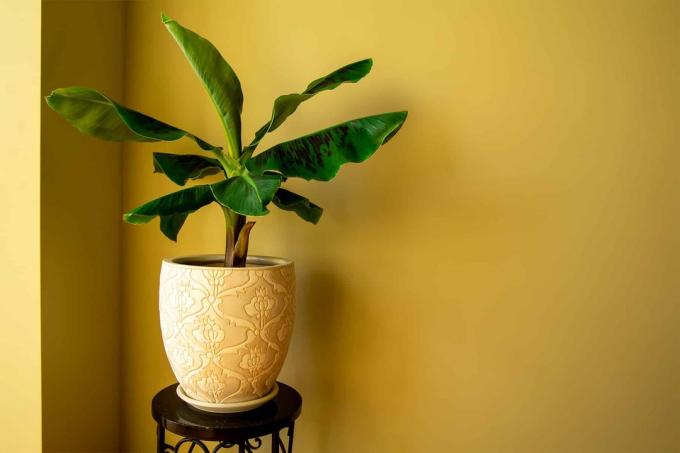
- Location: very bright, no drafts
- Flower: ornamental foliage plant
- Growth: upright, spreading
- Watering: do not let it dry out, avoid waterlogging
- Fertilize: weekly from spring to autumn; every four weeks in winter
Blue Lizzie
The blue Lieschen (Exacum affine) is a popular balcony plant, but it can also be cultivated all year round at room temperature.
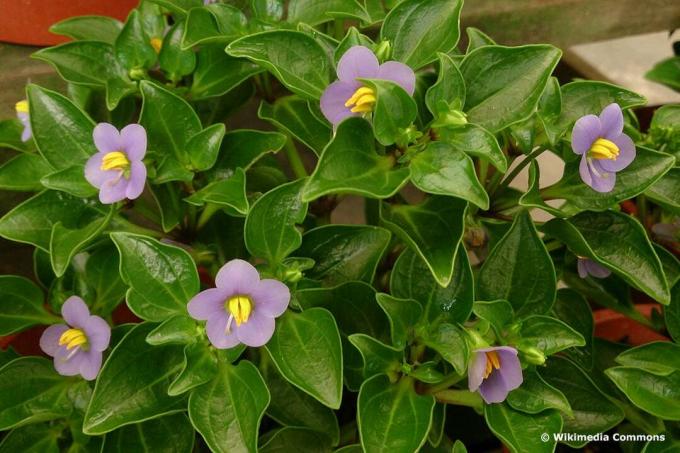
- Location: partial sun to semi-shade; morning and/or evening sun
- Flower: blue or white; from spring to autumn
- Growth: upright, up to about 20 centimeters high
- Watering: allow to dry slightly between waterings
- Fertilize: from April to September at intervals of between four and a maximum of eight weeks
A notice: In the first year after purchase or repotting, the Blaue Lieschen does not need any fertilizer.
money tree
The money tree (Crassula ovata) has fleshy foliagein which it stores water. As a lucky charm, the penny tree promises rich blessings, but only if it has many leaves.
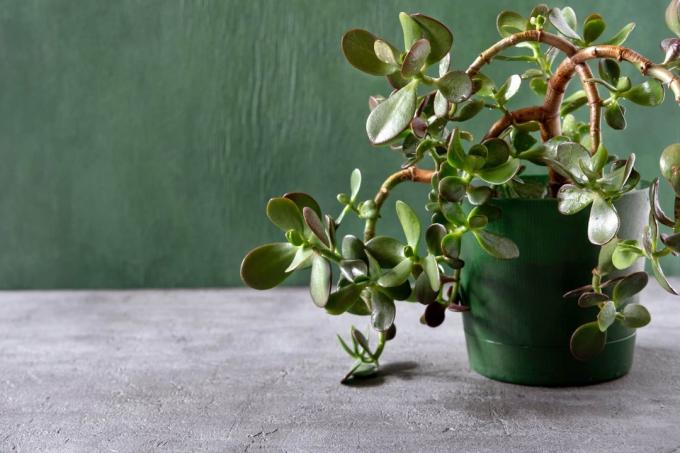
- Location: bright, sunny to semi-shady
- Flower: white or pink, from the age of ten
- Growth: upright, about 50 to 100 centimeters
- Watering: thoroughly on hot days, more sparingly in winter, very sensitive to waterlogging
- Fertilize: from April to September, every four weeks
antler fern
Of the roughly 18 species in the plant genus, Platycerium bifurcatum has established itself as a popular non-toxic houseplant.
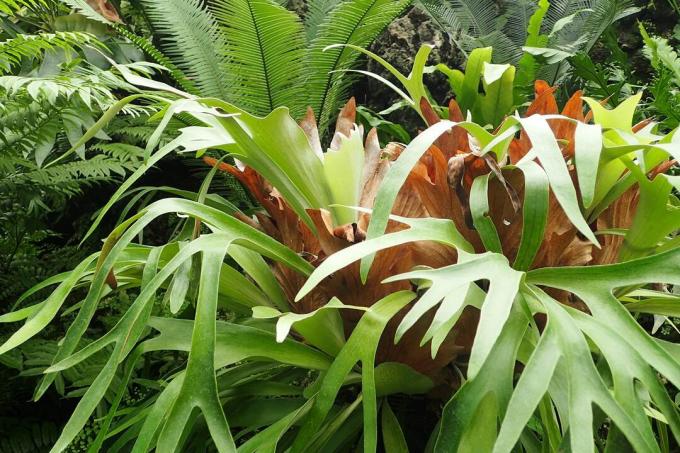
- Location: bright, semi-shady, high humidity is an advantage (bathroom plant)
- Flower: ornamental foliage plant
- Growth: bushy, arching hanging fronds; Maximum size 1 meter, suitable as a traffic light plant
- Watering: spray liberally or water between the old leaves
- Fertilize: every six weeks from spring to fall
golden fruit palm
The popular golden fruit palm (Dypsis lutescens) can reach a height of 3 meters. In the first few years, however, it grows rather slowly.

- Location: very bright, no direct sun, no draughts
- Flower: ornamental foliage plant
- Growth: upright, overhanging, loose
- Watering: keep constantly moist, do not let dry out
- Fertilize: weekly from spring to autumn; every three weeks in winter
K-M
coffee plant
The coffee plant (Coffea arabica) only found its way into living spaces a few years ago. However, it is enjoying increasing popularity.

- Location: bright, no direct sun, 18 to 22 degrees Celsius, no temperature fluctuations
- Flowers: white star flowers from April to May
- Habit: Shrub, 100 to 200 centimeters high
- Pour: water at room temperature, keep constantly moist
- Fertilize: weekly from April to September; in winter every four to six weeks
basket marante
Calathea are distinguished by their variegated or variegated leaves. Due to its countless variants, it has been one of the most popular non-toxic houseplants for years.
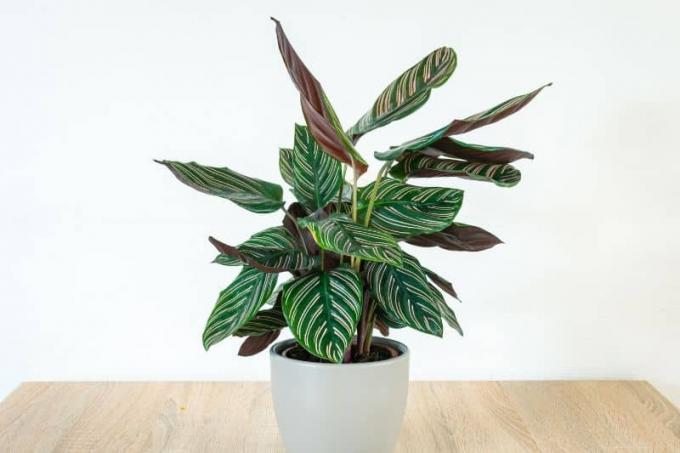
- Location: bright, warm, partially shaded, no direct sun, high humidity
- Flower: ornamental foliage plant
- Growth: upright
- Watering: regularly with low-lime, lukewarm water
- Fertilize: every two weeks from March to October; every six weeks in winter
A notice: The demands of the Korbmarante on humidity should not be underestimated. If the air at the location is too dry, it also shows curled leaves during the day.
mosaic plant
Species of the genus Fittonia impress with their colorful leaf veins, to which the mosaic plants also owe their name.

- Location: bright, morning and evening sun, high humidity ideal
- Flower: ornamental foliage plant
- Growth: upright to creeping
- Watering: keep evenly moist, avoid waterlogging
- Fertilize: from April to September, every four to eight weeks
A notice: If the mosaic plant is too dark, the colored leaves turn green.
R-S
rosette thickleaf
The rosette thickleaf (Aeonium arboreum) decorates the room not only with its green leaf rosettes, but also with its panicle blossoms in spring and summer when it is old.

- Location: sunny
- Flowers: golden yellow, panicles 25 to 30 centimeters high
- Habit: upright, branched trunks (up to 1 meter), green leaf rosettes at the ends of the shoots
- Watering: Allow substrate surface to dry between waterings
- Fertilize: every two weeks from spring to autumn
shamflower
The shamflower (Aeschynanthus) is a rainforest plant that loves high humidity. Therefore, the popular non-toxic houseplant is also suitable for the bright bathroom.

- Location: bright, warm (20 to 25 degrees Celsius), high humidity, no direct sun
- flower: red, orange-red or yellow; tubular clusters of flowers, from June to September
- Habit: hanging, shoots up to 60 centimeters long, traffic light plant
- Watering: lukewarm water, do not let it dry out, avoid waterlogging
- Fertilize: from March to August every two to three weeks, lightly dosed
shield fern
The shield fern (Polystichum tsus-simense) grows compactly. Its leaf fronds are dark green.

- Location: partially shaded to shaded; no direct sun
- Flower: ornamental foliage plant
- Growth: upright, arching, 20 to 40 centimeters high
- Watering: keep constantly moist, avoid waterlogging
- Fertilize: every four weeks from April to September
sword fern
Sword ferns (Nephrolepis exaltata) are often recommended for the bathroom, but also develop very well in other rooms if the location suits their needs.

- Location: shady, morning and evening sun is tolerated
- Growth: upright with overhanging fronds
- Watering: keep constantly moist, avoid waterlogging
- Fertilize: once a week from spring to autumn; every four weeks in winter
A notice: Sword ferns can be very old and very large - over 2 meters in diameter. However, these specimens do not like being repotted.
stick palm
With a Growth height of up to 2 meters the easy-care stick palm (Rhapis excelsa) is a real eye-catcher among indoor palms.
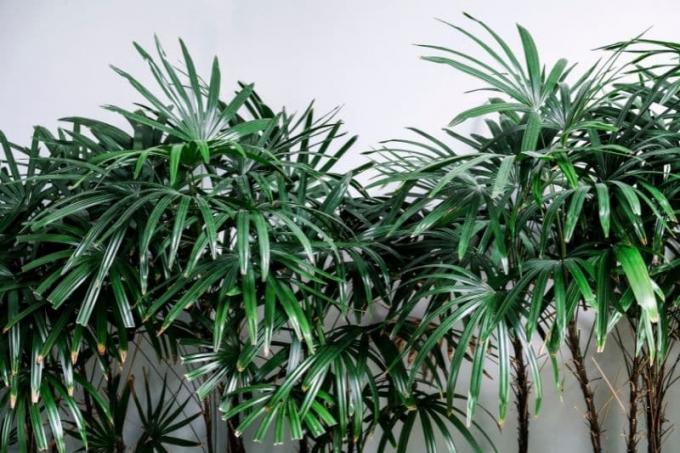
- Location: partially shaded to shaded, no direct sun
- Flowers: white to ivory, very rare in indoor plants
- Growth: upright, dense, bushy
- Watering: medium water requirement, don't let it dry out
- Fertilize: every two weeks from May to September
T-Z
tapir flower
The evergreen tapir flower (Crossandra infundibuliformis) subshrub. Its bright flowers contrast beautifully with the dark green foliage.
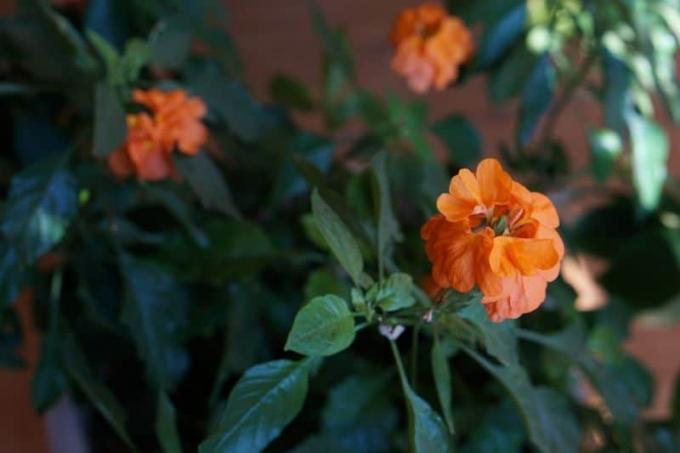
- Location: bright, shady, ideal room temperature
- Flowering: orange, pink or salmon-colored, from May to September
- Growth: upright, bushy, 40 to 50 centimeters high
- Watering: regularly with room-warm water
- Fertilize: once a week during flowering
African violets
African violets (Saintpaulina ionantha) are perennial bloomers. Their evergreen leaf rosettes reach a diameter of up to 20 centimetres.
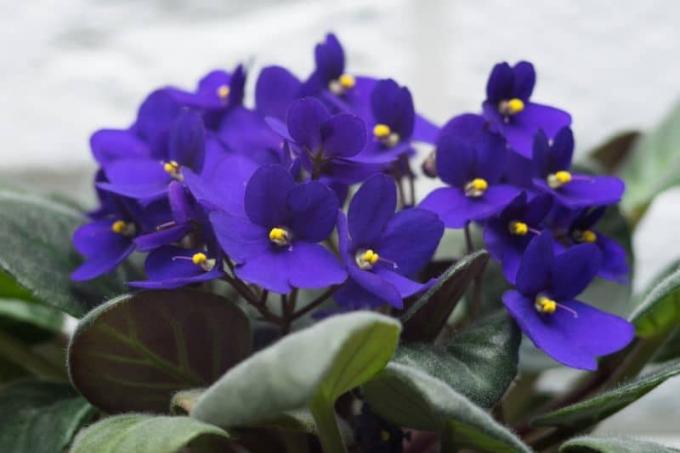
- Location: bright, without direct sun, room temperature, pay attention to high humidity
- Flower: white, pink, violet; single or double, bright yellow center
- Growth: upright, up to 15 centimeters high
- Watering: keep evenly moist, avoid waterlogging
- Fertilize: every three weeks, all year round
Tip: The velvety soft leaves of the African violets are extremely sensitive to moisture. Therefore you are allowed to use the plantdo not spray or wet when wateringn.
indoor hibiscus
The indoor hibiscus is the Chinese rose mallow (Hibicus rosa-sinensis). With good care, the shrub can grow up to 3 meters high.
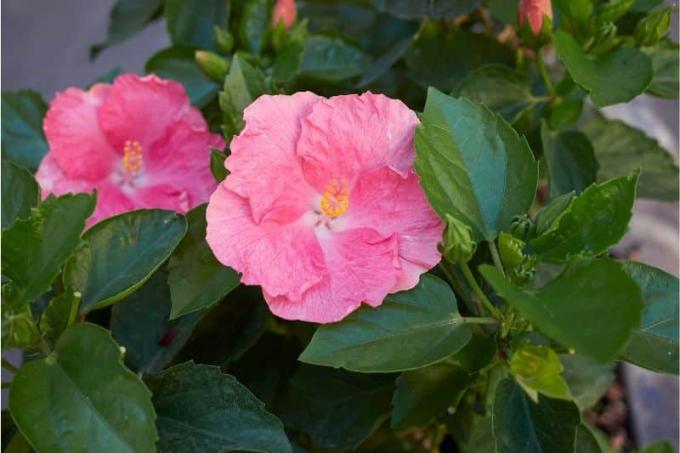
- Location: bright, morning or evening sun; avoid blazing midday sun
- Flower: different colors, funnel-shaped flowers, up to 10 centimeters in diameter; from February to October
- Growth: shrub
- Watering: plentiful, avoid waterlogging
- Fertilize: weekly from February to September
indoor fir
The Room fir (Auracaria heterophylla) comes into its own as a solitaire. The room temperature should not exceed 20 degrees Celsius.

- Location: bright but not too sunny
- Growth: conical coniferous tree, 1 to 2 meters high
- Watering: keep moderately moist, lime-poor water
- Fertilize: every two weeks in spring and summer
Bromeliads are non-toxic to humans and pets. However, since there are small barbs on the edge of the leaves, you should avoid indoor plants if there are small children in the household.
In that case, you should Place the plant out of the cat's reach. You can also her Cat grass as an alternative offer.
Small children and pets have an innate urge to explore, so despite all caution, it can happen that one does poisonous houseplant comes into their hands. The most common symptoms of poisoning include vomiting, diarrhea, gastrointestinal problems and irritation of the mucous membranes. More severe poisoning is shown by cramps, shortness of breath, dizziness and tremors up to fainting and cardiac arrest. For this reason, if you suspect something and the first signs of it appear, you should seek medical help immediately. Important: take the plant or vomit with you to the specialist.
